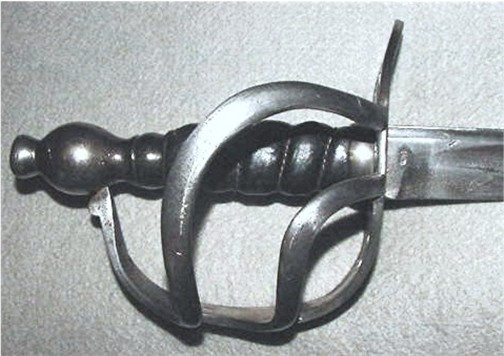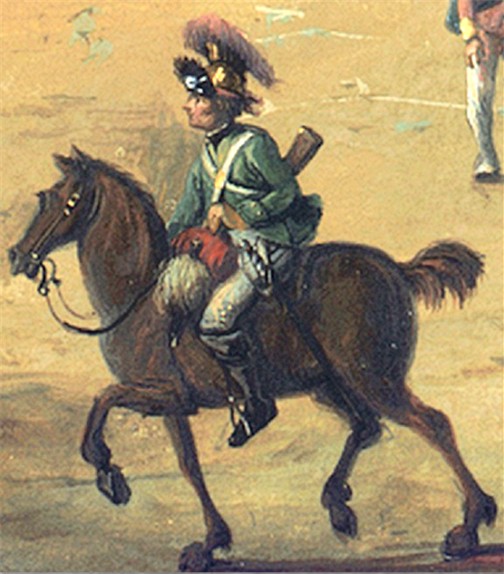|
1760 PATTERN BRITISH LIGHT DRAGOON SABER – VERY
NICE EXAMPLE OF A VERY RARE AMERICAN REVOLUTIONARY WAR
ERA SABRE: This very historic British Army 1760
Pattern Light Dragoon Sabre was carried by the British
light dragoons who served in North America during the
American Revolutionary War, and between battlefield
recoveries and the ultimate surrender of British forces,
eventually fell into the hands of the American mounted
troopers. Relatively unknown as compared to other
British and American sabres, these 1760 Pattern Sabres
have an interesting history and they are definitely a
significant artifact of American military history.
In preparation for
deploying troops onto the European Continent at the
beginning of the Seven Years War, in 1759 Britain
created five new regiments of Light Dragoons. European
nations had reached the consensus that the existing
regiments of Heavy Dragoons were expensive to raise,
equip, and maintain, and they lacked flexibility on the
battlefield. Not only would the new regiments of Light
Dragoons be less expensive to create and support, it was
believed they would be better suited to a wider variety
of duties on the battlefield, such as sentinel
assignments in advance of pickets, reconnaissance,
scouting, and protecting the flanks of the main force.
One of the primary differences between the Light and
Heavy Dragoons was the size of the horse – the Heavy
Dragoons which rode larger, heavier framed horses served
as shock troops against an enemy formation, while the
Light Dragoons were mounted on lighter boned horses
chosen for speed and agility, more in keeping with Light
Dragoons’ intended assignments. In kind, the Light
Dragoons were armed and equipped with lighter weapons
such as this 1760 Pattern Light Dragoon Sabre, also
known as the 1760 Light Horseman Sabre.
George C. Neumann shows this exact pattern of sabre on
page 347 of his seminal work, Battle Weapons of the
American Revolution. He lists the sabre under his
code number 132.SS, titled as the “English Light
Horseman Saber ca. 1760-1788”. Neumann’s example is
stamped with the same “Crown/9” inspection stamp which
is appears on the sabre offered here. Both Neumann’s
example and this sabre are identical in every other
feature.

Only two of these Light Dragoon
Regiments were dispatched to North America to reinforce
the British Army’s “American Garrison” during the
American Revolutionary War – the 16TH and 17TH
Light Dragoons (LD). An interesting intersection of
historical record emerged during the War. The first
colonel chosen to command the 16TH LD, tasked
with recruiting, mounting, and equipping the new unit,
as well as developing appropriate training and tactics,
was none other than “Gentleman” John Burgoyne, who would
arrive in America as a major general and serve at Boston
in 1775, and then in Quebec and New York where in 1777
his forces were defeated at Saratoga and he was forced
to surrender.
After serving with
distinction on their first overseas deployment in
Portugal against the French and Spanish during the Seven
Years War, the 16TH LD and 17TH LD
were dispatched to North America. The 16Th
LD landed in Halifax, Nova Scotia in October, 1776 and
within a week was engaged at the Battle of White Plains,
New York. After that campaign, the regiment was
primarily employed in patrol and garrison duties, and it
returned to England in 1779 prior to the end of the
war.
The 17TH
LD arrived in Boston just weeks before the Battle of
Bunker Hill in 1775, and the regiment served in many
campaigns of the war, including Boston, Long Island, and
Philadelphia, and served with distinction with Colonel
Tarleton and the British Legion during the Southern
Campaign.
The 17TH was transferred to Philadelphia in
the fall of 1777 and were present at the Battle of
Germantown in October. Troopers of the 17TH
LD featured prominently in the contemporary painting of
that battle by
Xavier Della Gatta which
now hangs in the Valley Forge Historical Society
collection. The painting is believed to have been
commissioned by an unknown British officer, and given
the positioning of the 17TH Light Dragoons in
the foreground, it is conceivable that the officer
served in that very regiment.

This painting is significant to
this offering as at least one of the 17TH
Light Dragoons painted in detail in Gatta’s rendering of
the battle is wearing the 1760 Pattern Light Dragoon
Sabre with its distinctive guard and urn-shaped pommel
plainly depicted. The description of the sabre must
have been provided by the officer who commissioned the
painting, and there is little doubt he was quite
insistent as to the details in order that the sabre was
depicted this accurately by Gatta.
The presence of the 17TH LD continued to be
felt by the American forces throughout the remainder of
the war, with notably successful engagements in the
northern colonies, and upon being transferred to
Savannah in 1779, they joined the British Legion. The
regiment was involved in numerous engagements in the
south, and their mobility and performance illustrated
the value of Light Dragoons on the battlefield to both
the British and American commanders – a lesson which
would prove valuable as the United States began to move
west in the next century. The 17TH remained
in the field through the end of the war, surrendering in
1781 at Gloucester as Cornwallis surrendered across the
York River in Yorktown, and they were some of the last
British soldiers to leave America in 1783.
As the 17TH LD troopers became casualties,
and then upon their surrender, their sabres passed into
the possession of the American forces. So, it reasons
that at some point the 1760 Pattern Sabres were employed
by the American mounted soldiers until they were worn to
destruction or were replaced by a new pattern. That
this particular sabre was found in New York opens the
imagination to any number of different scenarios as to
how this sabre remained behind when the British Forces
departed for home.
British Heavy and Light Dragoon Sabres generally
featured straight blades until the 1796 Pattern Light
Dragoon Sabre was adopted. The Heavy Dragoon sabres
bore a strong resemblance to the Scottish Broadsword
with their full basket guard, large grip and heavy
blade. The design of the 1760 Pattern Light Horseman
Sabre was a distinct departure from those heavy blades,
and it began the trend towards more refined designs
which were less expensive to manufacture, lighter in
weight in consideration of both the soldiers and the
horses who carried them, and easier to wield.
Prior to 1788, the colonels of British regiments were
allocated a budget for the purchase of arms and
equipment, as opposed to a central top-down supply
system as we know it today. The colonels exercised
total control over the selection of the civilian
contractors and the pattern and quality of the arms - in
this case, the sabre. It is generally believed that in
order to stay within the budget, cost was more often the
chief concern rather than quality. This practice is
revealed in the characteristics of this sabre with the
iron rather than brass guard, a somewhat crude grip, and
indications of minimal polishing of the metal surfaces.
This 1760 Pattern Light Dragoon Sabre presents in very
nice condition, retaining its full form and length, and
while showing evidence of service, is not damaged by
abuse or neglect.
The blade is generally bright with no heavy pitting,
limited frosting and some minor pitting peppered evenly
over the surface. The majority of the blade surface
still retains a smooth, bright, shiny surface. The
blade is full length at 36” and has not been sharpened
out of profile or shortened. The edge is straight and
even with a couple of small nicks, only one of which is
visually apparent. The blade is legibly stamped with
the British “Viewer’s” or inspector’s mark – the
government crown over the numeral nine – the number
denoting the inspector.
The iron guard is full form with no bending or
misshaping, and it is seated tightly on the tang. The
iron surfaces are clean and bright with light frosting
and some minor pitting present. The interior of the
branches show some of the original forging marks which
were not polished out at the time of manufacture,
additional evidence that controlling cost was a concern
to the regimental commanders. The guard assembly is
attached to the tang with what appears to be the
original peening of the end of the tang, and there is no
evidence that it has ever been tampered with.
The grips on the extant 1760 Pattern Sabres all seem to
share the same characteristics, in so far that they were
made of wood, featured a spiral groove, and were covered
in black leather which was secured with a twisted brass
wire wrap. The base wooden grips all appear to be hand
carved – including the spiral groove – and the shaping
was executed somewhat crudely, with irregularities and
flat chisel or knife cuts left visible with no effort
having been made to smooth the surface by sanding. On
those grips which the leather covering has survived
intact, the carving marks are plainly visible under the
light weight black leather used to cover the grip.
The grip on this sabre is covered with lightweight black
leather and secured with a single wrapping of twisted
brass wire. Given the age and overall condition of this
sabre and based on the condition of the leather
covering, I have to assume that the leather was replaced
at sometime in the sabre’s life, however if this is the
case, it was very nicely executed by skilled hands –
perhaps during an arsenal refurbishing. The leather
wrap is very tight and secure and it does not present as
a cheap or careless later addition.
The 1760 Pattern Light Horseman Sabre remained in
service until replaced by the 1788 Pattern Light Cavalry
Sabre, in service through two major conflicts – The
Seven Years War and the American Revolutionary War. The
1760 Pattern was only intended for use by the five
regiments of Light Dragoons, so as a result they were
produced in very limited numbers and in turn, their
survival rate has been proportionately low which is
evidenced by their rarity on the market today.
This 1760 Pattern Light Dragoon Sabre is a very
attractive historical saber from the early days of our
nation’s history. This specimen presents in very nice
condition and it will be a pleasure to own with no need
to upgrade it. (0439) $3250
|

